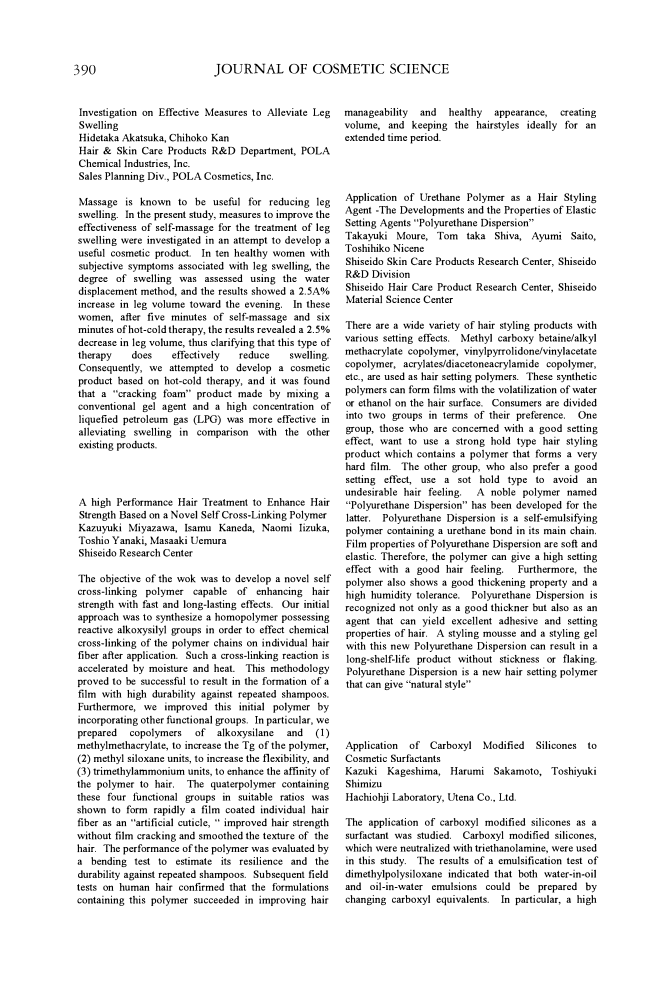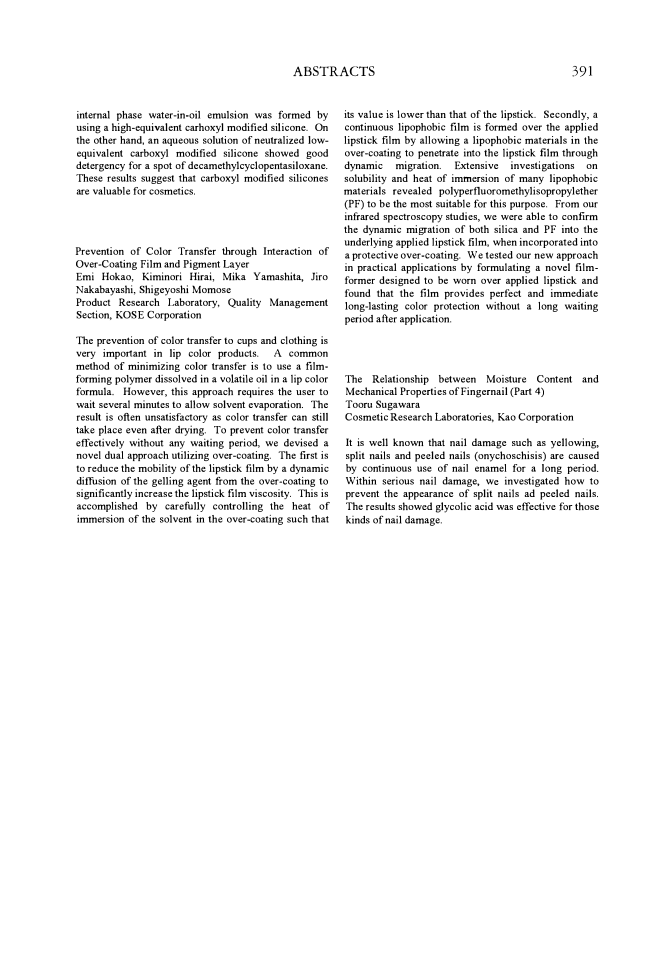390 JOURNAL OF COSMETIC SCIENCE Investigation on Effective Measures to Alleviate Leg Swelling Hidetaka Akatsuka, Chihoko Kan Hair & Skin Care Products R&D Department, POLA Chemical Industries, Inc. Sales Planning Div., POLA Cosmetics, Inc. Massage is known to be useful for reducing leg swelling. In the present study, measures to improve the effectiveness of self-massage for the treatment of leg swelling were investigated in an attempt to develop a useful cosmetic product. In ten healthy women with subjective symptoms associated with leg swelling, the degree of swelling was assessed using the water displacement method, and the results showed a 2.5A% increase in leg volume toward the evening. In these women, after five minutes of self-massage and six minutes of hot-cold therapy, the results revealed a 2.5% decrease in leg volume, thus clarifying that this type of therapy does effectively reduce swelling. Consequently, we attempted to develop a cosmetic product based on hot-cold therapy, and it was found that a "cracking foam" product made by mixing a conventional gel agent and a high concentration of liquefied petroleum gas (LPG) was more effective in alleviating swelling in comparison with the other existing products. A high Performance Hair Treatment to Enhance Hair Strength Based on a Novel Self Cross-Linking Polymer Kazuyuki Miyazawa, Isamu Kaneda, Naomi Iizuka, Toshia Yanaki, Masaaki Uemura Shiseido Research Center The objective of the wok was to develop a novel self cross-linking polymer capable of enhancing hair strength with fast and long-lasting effects. Our initial approach was to synthesize a homopolymer possessing reactive alkoxysilyl groups in order to effect chemical cross-linking of the polymer chains on individual hair fiber after application. Such a cross-linking reaction is accelerated by moisture and heat. This methodology proved to be successful to result in the formation of a film with high durability against repeated shampoos. Furthermore, we improved this initial polymer by incorporating other functional groups. In particular, we prepared copolymers of alkoxysilane and (1) methylmethacrylate, to increase the Tg of the polymer, (2) methyl siloxane units, to increase the flexibility, and (3) trimethylammonium units, to enhance the affinity of the polymer to hair. The quaterpolymer containing these four functional groups in suitable ratios was shown to form rapidly a film coated individual hair fiber as an "artificial cuticle, " improved hair strength without film cracking and smoothed the texture of the hair. The performance of the polymer was evaluated by a bending test to estimate its resilience and the durability against repeated shampoos. Subsequent field tests on human hair confirmed that the formulations containing this polymer succeeded in improving hair manageability and healthy appearance, creating volume, and keeping the hairstyles ideally for an extended time period. Application of Urethane Polymer as a Hair Styling Agent -The Developments and the Properties of Elastic Setting Agents "Polyurethane Dispersion" Takayuki Moure, Tom taka Shiva, Ayumi Saito, Toshihiko Nicene Shiseido Skin Care Products Research Center, Shiseido R&D Division Shiseido Hair Care Product Research Center, Shiseido Material Science Center There are a wide variety of hair styling products with various setting effects. Methyl carboxy betaine/alkyl methacrylate copolymer, vinylpyrrolidone/vinylacetate copolymer, acrylates/ diacetoneacrylamide copolymer, etc., are used as hair setting polymers. These synthetic polymers can form films with the volatilization of water or ethanol on the hair surface. Consumers are divided into two groups in terms of their preference. One group, those who are concerned with a good setting effect, want to use a strong hold type hair styling product which contains a polymer that forms a very hard film. The other group, who also prefer a good setting effect, use a sot hold type to avoid an undesirable hair feeling. A noble polymer named "Polyurethane Dispersion" has been developed for the latter. Polyurethane Dispersion is a self-emulsifying polymer containing a urethane bond in its main chain. Film properties of Polyurethane Dispersion are soft and elastic. Therefore, the polymer can give a high setting effect with a good hair feeling. Furthermore, the polymer also shows a good thickening property and a high humidity tolerance. Polyurethane Dispersion is recognized not only as a good thickner but also as an agent that can yield excellent adhesive and setting properties of hair. A styling mousse and a styling gel with this new Polyurethane Dispersion can result in a long-shelf-life product without stickness or flaking. Polyurethane Dispersion is a new hair setting polymer that can give "natural style" Application of Carboxyl Modified Silicones to Cosmetic Surfactants Kazuki Kageshima, Harumi Sakamoto, Toshiyuki Shimizu Hachiohji Laboratory, Utena Co., Ltd. The application of carboxyl modified silicones as a surfactant was studied. Carboxyl modified silicones, which were neutralized with triethanolamine, were used in this study. The results of a emulsification test of dimethylpolysiloxane indicated that both water-in-oil and oil-in-water emulsions could be prepared by changing carboxyl equivalents. In particular, a high
ABSTRACTS 391 internal phase water-in-oil emulsion was formed by using a high-equivalent carhoxyl modified silicone. On the other hand, an aqueous solution of neutralized low equivalent carboxyl modified silicone showed good detergency for a spot of decamethylcyclopentasiloxane. These results suggest that carboxyl modified silicones are valuable for cosmetics. Prevention of Color Transfer through Interaction of Over-Coating Film and Pigment Layer Emi Hokao, Kiminori Hirai, Mika Yamashita, Jiro Nakabayashi, Shigeyoshi Momose Product Research Laboratory, Quality Management Section, KOSE Corporation The prevention of color transfer to cups and clothing is very important in lip color products. A common method of minimizing color transfer is to use a film forming polymer dissolved in a volatile oil in a lip color formula. However, this approach requires the user to wait several minutes to allow solvent evaporation. The result is often unsatisfactory as color transfer can still take place even after drying. To prevent color transfer effectively without any waiting period, we devised a novel dual approach utilizing over-coating. The first is to reduce the mobility of the lipstick film by a dynamic diffusion of the gelling agent from the over-coating to significantly increase the lipstick film viscosity. This is accomplished by carefully controlling the heat of immersion of the solvent in the over-coating such that its value is lower than that of the lipstick. Secondly, a continuous lipophobic film is formed over the applied lipstick film by allowing a lipophobic materials in the over-coating to penetrate into the lipstick film through dynamic migration. Extensive investigations on solubility and heat of immersion of many lipophobic materials revealed polyperfluoromethylisopropylether (PF) to be the most suitable for this purpose. From our infrared spectroscopy studies, we were able to confirm the dynamic migration of both silica and PF into the underlying applied lipstick film, when incorporated into a protective over-coating. We tested our new approach in practical applications by formulating a novel film former designed to be worn over applied lipstick and found that the film provides perfect and immediate long-lasting color protection without a long waiting period after application. The Relationship between Moisture Content and Mechanical Properties of Fingernail (Part 4) Tooru Sugawara Cosmetic Research Laboratories, Kao Corporation It is well known that nail damage such as yellowing, split nails and peeled nails ( onychoschisis) are caused by continuous use of nail enamel for a long period. Within serious nail damage, we investigated how to prevent the appearance of split nails ad peeled nails. The results showed glycolic acid was effective for those kinds of nail damage.
Purchased for the exclusive use of nofirst nolast (unknown) From: SCC Media Library & Resource Center (library.scconline.org)






































































































